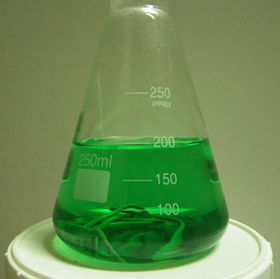Tetrachlorocupric acid
 |
This article is a stub. Please help Sciencemadness Wiki by expanding it, adding pictures, and improving existing text.
|
 Tetrachlorocupric acid formed from copper metal, hydrochloric acid, and hydrogen peroxide as an intermediate in the synthesis of copper(II) chloride
| |
| Properties | |
|---|---|
| H2CuCl4 | |
| Molar mass | 207.37 g/mol |
| Appearance | Green liquid (solution) |
| Melting point | Decomposes |
| Boiling point | Decomposes |
| Perfectly soluble, stable in acidic water | |
| Solubility | Insoluble in organic solvents, decomposes |
| Hazards | |
| Safety data sheet | None |
| Flash point | Non-flammable |
| Related compounds | |
| Related compounds
|
Hydrochloric acid Copper(II) chloride |
| Except where otherwise noted, data are given for materials in their standard state (at 25 °C [77 °F], 100 kPa). | |
| Infobox references | |
Tetrachlorocupric acid is an acid formed from the tetrachlorocuprate ion. It is not stable as a solid, rather converting back to hydrochloric acid and copper(II) chloride. However, it is an extremely useful printed circuit board (PCB) etchant.
Contents
Properties
Chemical
When exposed to copper, the tetrachlorocuprate ion comproportionates with the copper metal to form the dichlorocuprate(I) ion:
- CuCl42- + Cu → 2 CuCl2-
For simple etching, the presence of tetrachlorocuprate is enough to do the job. However, the acidity of tetrachlorocupric acid has the added bonus of allowing the solution to regenerate and be reused when exposed to air:
- 4 H+ + 8 Cl- + 4 CuCl2- + O2 → 4 CuCl42- + 2 H2O
This reaction can be accelerated by adding hydrogen peroxide.
Tetrachlorocuprates are able to dissolve many other metals, notably aluminum.
Physical
Tetrachlorocupric acid exists as a green solution due to the presence of tetrachlorocuprate ions. It is stable, but may emit some hydrogen chloride, so it should be stored in a capped container to prevent degradation.
Production
Pure tetrachlorocupric acid is not commerically available, but it can be made easily from hydrochloric acid and copper(II) chloride by mixing them together in a 2:1 molar ratio. It can also be made by dissolving copper(II) oxide, copper(II) carbonate, or copper(II) hydroxide in hydrochloric acid in a 4:1 molar ratio.
Crude tetrachlorocupric acid can be made by mixing 2 moles of a strong acid, 1 mole of a copper salt, and 4 moles of a chloride source, preferably sodium chloride or potassium chloride. The spectator ions should not interfere. Do not use nitric acid for this, as it will create aqua regia and decompose. (Nitric acid itself works as a PCB etchant.)
Projects
- PCB etching
Handling
Safety
Tetrachlorocupric acid is corrosive and poses some toxicity being a copper compound.
Storage
In closed bottles.
Disposal
Can be neutralize with any base.